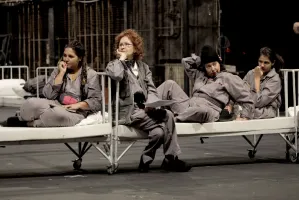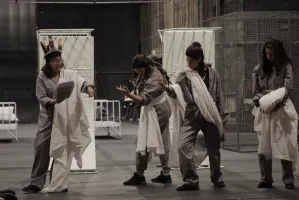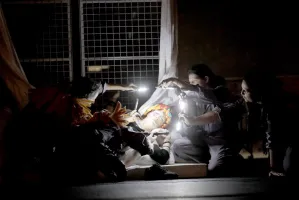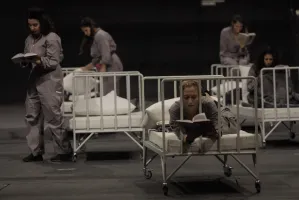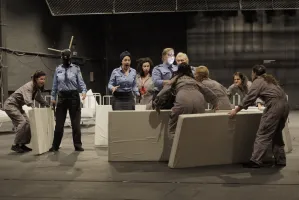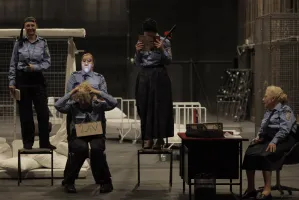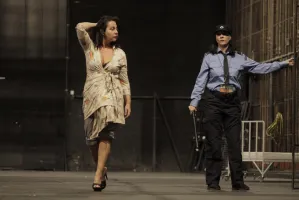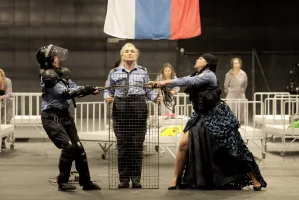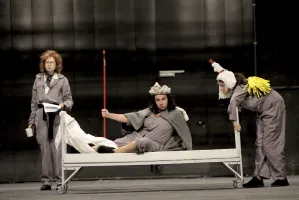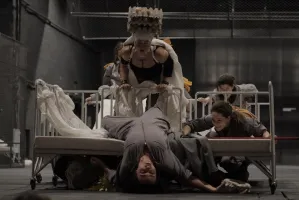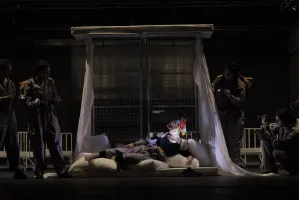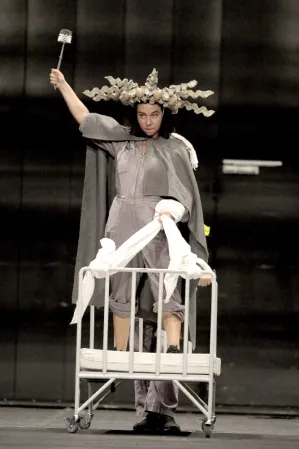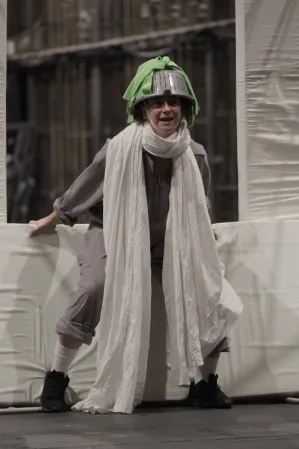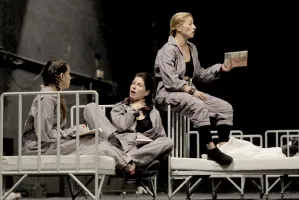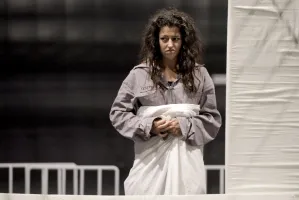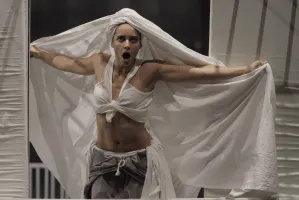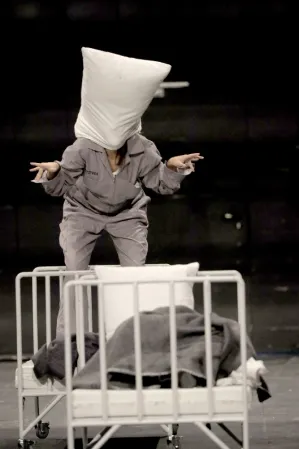A midsummer night's dream - project Shakespeare
after William Shakespeare’s play
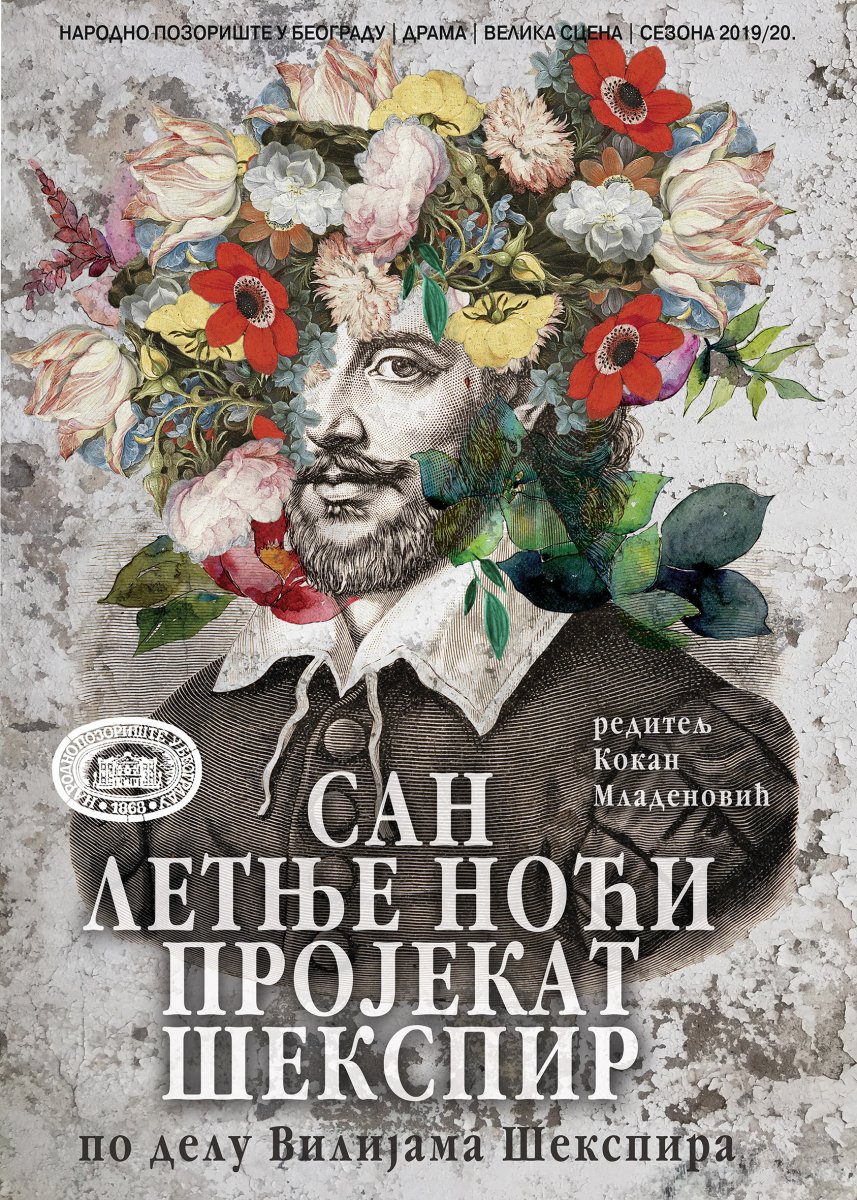
PROJECT SHAKESPEARE
A MIDSUMMER NIGHT’S DREAM
Various analyses of Shakespeare’s famous comedy A Midsummer Night’s Dream, starting from Jan Kott through Erika Fischer-Lichte, pertain to contextual units within the play in detail, providing explanation by unlocking meanings of other texts placed within this Shakespeare’s play, and also with structural analysis of the narration. The complexity of the play enables diverse approaches to its reading, so the different experts have varied points of view and focus on different, at times only individual elements of classical drama. There are many feminist readings of Shakespeare in general, and of the comedy A Midsummer Night’s Dream. In those readings, the mechanisms of patriarchal framework is that which opens such discussions: Theseus won Hippolyta with his sword, Egeus has all the power over his daughter Hermia’s life, the state has the power over freedom of their female citizens (Theseus threatens Hermia that if she does not obey her father, namely if she does not agree to patriarchate, she has to renounce her freedom), Oberon retaliates because Titania refuses to be obedient, there is also the manner Demetrius refuses Helena and her disappointment because of a man’s lack of interest for her… As Erica Fischer-Lichte states, “The Athenian law only recognises Hermia as the daughter of her father and does not allow her her own will, her own choice or right to self-determination. When she refuses to obey her father, she gives up the right to live and love.” Looking from the cultural background where we as contemporary theatre authors find ourselves today, Shakespeare’s text and its complexity remain a domain to question diverse phenomena of contemporary patriarchate. Though, not only the patriarchate itself, because it can be used as a complex structure for research of different positions of power within a certain system. It is interesting that Shakespeare’s plays are often being used for different interpretations and shaping of society, just as the theatre itself can be used in other social spheres outside the sphere of production of theatre pieces. Some of those actions are productions of Shakespeare’s works inside institutions for incarceration throughout the world. Most often, those are projects aiming at resocialisation, adaptation and intellectual/creative activation of inmates. In the production Project Shakespeare – A Midsummer Night’s Dream, the initial idea was to deal with this phenomenon regarding utilisation of Shakespeare’s text. It is not, therefore, a classical reading of a play by Shakespeare, instead it is a production tackling the phenomenon of using Shakespeare’s text in a prison, using the text by Shakespeare for the purposes of regulation and adaptation, i.e. for improvement of quality of living in prison. A Midsummer Night’s Dream thus becomes the means to shed light on social choreography of living in prison, i.e. on lives of individuals who have been incarcerated due to their illegal actions. The female inmates go through several phases of transformation while learning their roles and rehearsing the play after Shakespeare’s text. In this sense, the prison, i.e. the place where women are deprived of their freedom, both directly and symbolically represents the very system in which Theseus rules in Shakespeare’s story, while the forest, i.e. the possibility to transform and be free, in this text is not the forest, as in a geographic locality, but the space of Shakespeare’s text. In Project Shakespeare – A Midsummer Night’s Dream, the very play is being observed as a space for possible transformation and freedom, i.e. for the change. The forest at night in the original text becomes the place for new experiences for lovers, just as the reading of Shakespeare becomes a place for new experiences for the inmates. With this production, director Kokan Mladenović, for the third time in his career, negotiates the plateau of placing a classical drama text into a prison environment, thus setting a goal for the actresses to approach the drama literature characters not merely as actresses, but also from the position of documentary and quasi-documentary characters of inmates, in order to reveal the potential of drama literature’s influence on transformation of character of a person placed in isolation, subsequently discussing social and political phenomena of our everyday lives. This is Mladenović’s second production where he starts a dialogue with Shakespeare through the text of A Midsummer Night’s Dream (previous production took place in SNT in Novi Sad).
Dimitije Kokanov, Dramaturge
QUESTIONS ABOUT THEATRE
Can theatre change the world? “No, of course”, say the ones who change the world. But why do we dedicate our lives to theatre then, especially if we consider its power so clearly limited by a line drawn by our experience and skepticism? Is that because we do not believe in limits? In which way is the freedom of theatre limited and who limited it, if we don’t do it ourselves? What do we believe in, if we do not believe in absolute freedom? Reality? Shakespeare’s A Midsummer Night’s Dream is a story set outside the realm of reality, and the motif of forbidden love in a society where men are masters of women’s destinies has been frequently used for rebellion in drama literature, hasn’t it? The falling action created by Shakespeare uses a fantasy fairy world as a catalyst to unravel the actions, which is also set in the male principle, and can be witnessed in the relationship between Oberon and Titania, it has a happy ending, the ending which features clearly defined caste society? Therefore, the poet adheres to structure of reality and gives freedom to dreams? Can a prison theatre change anything in the life of an inmate, at least the one who has a little bit of conscience, who would give a kingdom for a couple of hours of sleep? Can theatre become space for freedom for them? Can tragedy, which is an integral part of their everyday life, be transformed in a clear ethical stance? In addition, what sort of theatre causes emotional reaction, the one imposed by owners of life and rules, or the one which concerns us? And, if it concerns us, does that mean that it has the power to change us?
Željko Hubač, Dramaturge
TRANSFORMATION AND DISCOVERING OF IDENTITY - FORM THE RITES OF MAY TO ‘RITE OF PASSAGE’
The experience of the four young lovers can most accurately be described as a rite de passage (a term from Arnold van Gennep), that is, a rite of transition. Such rites order the crises in our lives and require that we shed our old identity in favor of a new one – the passage from one kind of life into another (such as birth, initiation, marriage, pregnancy and giving birth, entry into a profession, promotion into a higher social class, death). The rite of passage itself is divided into three parts: separation from the normal situation in life, the threshold, or phase of actual transformation, and the incorporation or re-integration of the transformed person back into society. The lovers mark their separation by leaving Athens, the place where they spent their childhood and first fell in love, the place which is ruled by the father and the law. In the night wood, the phase of transformation begins. They shed their previous identities as daughter, friend, one who is loved, who is happy in love, one who is rejected and unrequited in love, as loyal lover, as fickle lover. Thus, they experience, on the one hand, a reversal of the roles that they have played so far and, on the other hand, an intensification of experiences undergone up to this point. The ‘eye-love’ which has directed their emotions until now is taken ad absurdum by the magic potion dropped onto their eyelids (the image of the eyes is a leitmotif for relations between lovers: it is used 68 times – including plural and composites – to which can also be added 39 examples of ‘see’ and 10 of ‘sight’). They experience sexual desire dominated by fear and divide love into divine love and sexual love which they cast with various different objects. The four lovers are transformed by their experiences in the night wood. Out of the ‘eyelove’ comes enduring love, and thus children become adults. After they have passed through the fog, which is ‘black as Acheron’ (the river of death), and overcome sleep, their old identities have worn off and they awake with new personal and social identities – as lovers who are constant, and as adults.The phase of transition is complete, the ‘trial period’ is over, and the newly transformed lovers must take their places in society once again. The incorporation phase can begin. […]
Society, changed for the better in this way, can now reintegrate the newly adult young lovers. This occurs with a further ‘rite de passage’ – the wedding – which creates a married couple out of single people; a final play by the mechanicals, the ‘most Lamentable Comedy and most Cruel Death of Pyramus and Thisbe’, at which the lovers, as spectators (implying a certain distance), follow a love story and comment on it (instead of being involved in it themselves); and, ultimately, the consummation of the marriage on the wedding night. In this manner, Hermia and Lysander, and Helena and Demetrius have been transformed: they have taken on new identities. The plot of the comedy relates the sequence of action borrowed from the May Rite to the phases of a rite of transition: the escape from the city marks the separation from the usual life situation; the stay in the night forest is realised as threshold, or liminal phase in which the old identities are dissolved and new experiences lead to taking on new identities; and the return to the city marks the beginning of the incorporation phase, which is passed at the wedding and at the play which follows it, and ends with the wedding night. In this way, the play presents a far-reaching change in the collective experience. Whilst the May Rite – like the Grocer’s scene in the Easter Play (see Chapter 1) – is performed in order to guarantee the community a magic renewal of vitality, which can also be executed as the collective-anarchic liberation of youth and sexuality (‘of forty, three-score, or a hundred maids going to the wood over night, there have scarcely the third part of them returned home again undefiled’), the rite of transition enables youths to bring their sexuality under control in accordance with society and to live out their sexual desires only in the form of a marriage sanctioned by society. The transformation of a May Rite into a rite of transition, which A Midsummer Night’s Dream achieves, recovers that which was lost in the suppression of popular culture by Puritan society and brings it back into society in a socially acceptable form. The community, which formerly carried out the May Rite, become spectators who, like the young couple at the play of ‘Pyramus and Thisbe’, watch others acting as representatives, as it were, in place of them and, thus, can achieve a distance to and distancing consciousness of the (own) actions.
Erika Fischer-Lichte, History of European Drama and Theatre, Routledge, London and New York, 2002, translated by Jo Riley
BLIND CUPID AND THE GOLDEN ASS – ON METAMORPHOSES IN A MIDSUMMER NIGHT’S DREAM
For an interpreter a “text” does not exist independently of its readings. Great text, and perhaps even more so quotations from classical texts, literal or parodistic, form, together with their readings, a lit-erary and cultural tradition. The classical texts are constantly rewritten, they are “the writerly texts”, to use Barthers’s term. Interpretations and commentaries become a part of their life. Classical texts and quotations continuously repeated are active in intellectual emanation which gives them new meaning and changes old ones. This emanation is the history of the classical text as well as the his-tory hidden in the literary text. Classical texts converse among themselves. But borrowings and quotations are never neutral. Each quotation enlists its own context to challenge the author’s text for better understanding of for mockery. The literary tradition, “the writerly text,” works forward and backward, constructing and destroying the classical texts, illuminating or disintegrating them, con-secrating or desecrating, or both. The literary history is, in a very literal sense, the eating and digest-ing of the classical texts. For an interpreter, the function of borrowing and the place of borrowed text in the plot or the man-ner of its “dramatization” in a dialogue are important.
Jan Kott, excerpt from The Botom Translation
SHAKESPEARE’S MATERIAL FOR A MIDSUMMER NIGHT’S DREAM
A Midsummer Night’s Dream was published for the first time in 1600 in a quarto edition, another issue, slightly altered, was published the same year. The play was labelled as drama fantasy and a poetic drama and belongs, most certanly, to Shakespeare’s early period. F. Meres mentions the play in 1598, but it was written and probably performed already during 1594-95, on occasion of a marriage celebration in a noble’s home. A Midsummer Night’s Dream is one of rare plays for which Shakespeare devised original plot. The plot covers four stories, and Shakespeare could have found the motifs for those stories in literature of the time. The first story about the wedding of Theseus and Hippolyta can be found in Plutarch’s Life of Theseus (translated into English in 1579) and J. Chaucer’s The Knight’s Tale (in The Canterbury Tales, published in 1475). The second story, the story about Athenian lovers is Shakespeare’s, but the motif of a magic flower was borrowed from Spanish pastoral romance by J. de Montemayor, The Seven Books of Diana. The third story, about the quarrel between Oberon and Titania, is also Shakespeare’s, although the fairy world has been undoubtedly taken from folklore and literature. Namely, Oberon, the King of the Fairies, originates from German mythology (Alberich, Elferich), and in France he becomes Alberon – Oberon and can be found in a once popular French epic poem Huon of Bordeaux (from 13th century), which was translated into English, in prose, in 1534. On the other hand, Titania, the Queen of Fairies, is Ovid’s Diana; in Metamorphoses, she is in company of Nymphs, her ladies of the court, similar to the fairies who accompany Titania in A Midsummer Night’s Dream. Puck is a sprite, an impish trickster in folklore tradition. The story of craftsmen is originally Shakespeare’s, however the story of Pyramus and Thisbe can also be found in Ovid’s Metamorphoses. A Midsummer Night’s Dream was first translated into our language, from German, by Dragomir Brzak in 1902, and then published in ‘The Bosnian Fairy’, a magazine for ‘entertainment, education and literature’, established by the Association of Teachers of the Serbian School in Sarajevo in 1885. A Midsummer Night’s Dream was produced for the first time in the National Theatre in Belgrade in 1910; Brzak’s translation was used and the production was directed by Milorad Gavrilović.
Edited by dramaturge Željko Hubač
 WILLIAM SHAKESPEARE (1564-1616)
WILLIAM SHAKESPEARE (1564-1616)
23rd April 1564 Shakespeare was born in Stratford-upon-Avon.
1582 William Shakespeare married Anne Hathaway.
1583 Their daughter Susana was born.
1585 wins Hamnet and Judith born. William Shakespeare leaves for London.
1589-90 Shakespeare writes HENRY VI (Part One)
1590-91 Shakespeare writes HENRY VI (Part Two) and HENRY VI (Part Three)
1592-93 Shakespeare writes RICHARD III and TITUS ANDRONICUS
1593-94 THE COMEDY OF ERRORS and THE TAMING OF THE SHREW
1594-95 THE TWO GENTLEMEN OF VERONA and LOVE’S LABOUR’S LOST
1595-96. ROMEO AND JULIET, KING RICHARD II and A MIDSUMMER NIGHT’S DREAM. His only son Hamnet dies at the age of 11.
1596-97 Shakespeare writes KING JOHN, THE MERCHANT OF VENICE. He purchases New Palace in Stratford.
1597-98 Shakespeare writes HENRY IV (Part One), HENRY IV (Part Two) and performs in Every man in his humour by Ben Johnson, at “The Curtain” Theatre.
1598-99 Shakespeare writes MUCH ADO ABOUT NOTHING, HENRY V, THE MERRY WIVES OF WINDSOR. ”The Theatre” in Shoreditch was pulled down, rebuilt and opened again in Southwark by James Burbage under the name “The Globe”, seating the audience of 1200. Shakespeare was a co-owner with 1/10 of share.
1599 Shakespeare writes JULIUS CAESAR, AS YOU LIKE IT, THE TWELFTH NIGHT
1600-01 Shakespeare writes HAMLET
1601-02 Shakespeare writes TROILUS AND CRESSIDA
1602-03 Shakespeare writes ALL’S WELL THAT ENDS WELL, OTHELLO
1603 Shakespeare writes MEASURE FOR MEASURE
1604-05 Shakespeare writes KING LEAR
1605-06 Shakespeare writes MACBETH
1606-07 Shakespeare writes ANTHONY AND CLEOPATRA, TIMON OF ATHENS
1607-08 Shakespeare writes CORIOLANUS. He was one of the founders of Blackfriars Theatre.
1608-09 Shakespeare writes PERICLES and THE SONNETS
1609-10 Shakespeare writes CYMBELINE
1610-11 Shakespeare writes THE WINTER’S TALE
1611-12 Shakespeare writes THE TEMPEST
1612-13 Shakespeare writes HENRY VIII
23rd April 1616 Shakespeare died of fever, after partying with Ben Johnson and Michael Drayton.
 KOKAN MLADENOVIĆ
KOKAN MLADENOVIĆ
Mladenović was born in Niš, Serbia, in 1970. He finished the Acting High School in Niš, under the mentorship of Mima Vuković-Kurić. He graduated from the Department for Theatre and Radio Directing at the Faculty of Dramatic Arts in Belgrade in 1995, mentored by Professor Miroslav Belović and Professor Nikola Jevtić.
Selection of his works: W. Shakespeare, L. Bunuel, H. Miller, Hamlet; D. Kharms Cases; T. de Molina, The Trickster of Seville and the Stone Guest; Beaumarchais, The Marriage of Figaro; Aristophanes, Lysistrata, Peace, Justice; A. Kristof, The Notebook; D. Kovačević, The Marathon Runners Are Running an Honorary Lap, Balkan Spy, The Meeting Point; H. Ibsen, Peer Gynt; A. Popović, The Path of Development of Bora Šnajder, The Spawning of the Carp; W. Shakespeare, Twelfth Night, A Midsummer Night’s Dream, The Taming of the Shrew, Romeo and Julia; Lj. Simović, The Šopalović Travelling Troupe; A. Baricco, Homer, Iliad; G. Petrović/K. Mladenović, Siege of the Saint Salvation Church; V. Lukić, The Affair of Innocent Annabelle; S. Selenić, Spiting the Nation in Two Parts; G. Stefanovski, Bacchanalias; M. Bulgakov/K. Mladenović, The Master and Margarita; V. Ognjenović, How to Make a Master Laugh, Was There the Prince’s Dinner?; J. R. R. Tolkien/K. Mladenović, Hobbit; J. M. Barrie, Peter Pan; E. Walsh, Disco Pigs; S. Basara, New Stradia; Fosse/Kander/Ebb, Chicago; Rado/Ragni/MacDermot, Hair; I. Madach, The Tragedy of Man; M. Pelević, The Orange Peel, I or Someone Else, Jumpgirl; C. Goldoni, The Servant of Two Masters; K. Mladenović/M. Grubić, Zona Zamfirova, a musical after Stevan Sremac’s novel; Beaumarchais/Mladenović/Đarmati, Opera Ultima; Aeschylus, Prometheus Bound; A. Dumas, The Three Musketeers; M. Cervantes, Don Quixote; B. Nušić, DR; Lars von Trier, Dogville; M. Bogavac, Jami District; authored project If only Sombor were Hollywood; V. Mayakovsky, A Cloud in Trousers; G. Chevallier, Clochemerle; N. Romčević, Caroline Neuber; B. Ilić/K. Mladenović, The Fall, authored project Noah’s Macedonia and Swan Lake Revisited…
Mladenović has successfully staged productions in theatres in Serbia, Slovenia, Hungary, Croatia, Romania, Bosnia and Herzegovina, Montenegro and Macedonia. He was an artistic director of the “Dadov” Youth Theatre, director and artistic director of the National Theatre in Sombor, director of the Drama department of the National Theatre in Belgrade and general manager of the Atelier 212 in Belgrade. Mladenović was awarded with the “Bojan Stupica” Award, as well as numerous other significant awards, such as: five Sterija Awards, “Bora Mihajlović” Award, “Ardalion” Award at the Festival in Užice, Grand Prix for directing at the International Theatre Festival in Budapest, four “Zlatni ćuran” awards at the Days of Comedy Festival in Jagodina, four “Joakim Vujić” awards at the Vojvodina Theatre Festival, five awards at the Festival of Classics in Vršac, two awards at the Festival of Theatre World Premiers in Paraćin, three awards at the Festival of World Premieres in Aleksinac, award for directing at the Kotor Festival, Golden Plaque at the “Mokranjac Days” Festival in Negotin and Golden Plaque at the “Days of Zoran Radmilović” Festival in Zaječar, as well as numerous professional recognitions and annual awards from theatres where he directed.
A Midsummer Night’s Dream – Shakespeare Project is his fifth production in the National Theatre in Belgrade.
Premiere performance
Premiere 8. october 2019/Main stage
Based on William Shakespeare’s Play, translated by Aleksandar Petrović
Director Kokan Mladenović
Adaptation Kokan Mladenović, Dimitrije Kokanov and Željko Hubač
Dramaturges Dimitrije Kokanov and Željko Hubač
Costume Designer Bojana Nikitović
Set Designer Marija Kalabić
Composer Irena Popović Dragović
Vocal Coach Dejan Sredojević
Premiere cast:
Prison Warden Radmila Živković
Professor Aleksandra Nikolić
Oberon Dušanka Stojanović Glid
Titania Vanja Ejdus
Puck Sanja Marković
Demetrius Marija Vicković
Helena Nina Nešković
Lysander Jovana Belović
Hermia Isidora Simijanović
Egeus Ivana Šćepanović
Bottom/ Pyramus Danijela Ugrenović
Wall Lidija Pletl
Thisbe Vanja Milačić
Moonshine Bojana Bambić
Cabinet Minister Milena Đorđević
Assistant Director Nevena Mijatović
Assistant Costume Designer Aleksandra Pecić
Assistant Set Designer Uroš Danilović
Producers Vuk Miletić and Jasmina Urošević
Stage Manager Sanja Ugrinić Mimica
Prompter Danica Stevanović
*Second year students at the Department of Theatre Directing at the Faculty of Dramatic Arts in training Katarina Vještica, Iva Olujić, Đorđe Nešović, Nikola Bundalo
Light Operater Milivoje Milivojević
Make-up Marko Dukić
Stage Crew Chief Branko Perišić
Sound Operater Perica Ćurković
Sets and costumes were manufactured in the NationalTtheatre workshops


